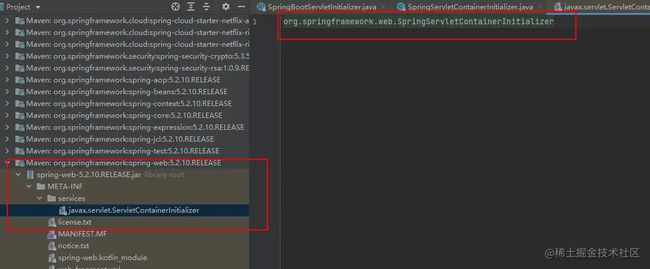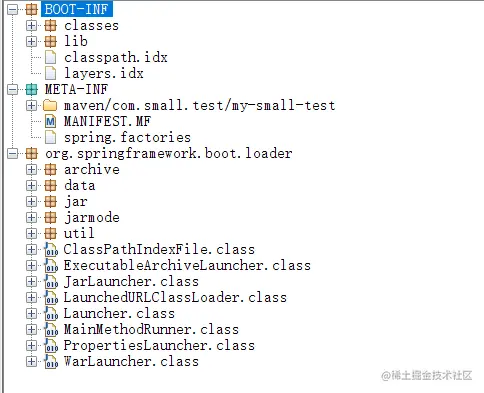一、jar包和war包的区别
1.1 war包
war包是Java Web应用程序的一种打包方式符合Servlet标准,它是Web Archive的缩写,主要用于存储Web应用程序相关的文件,包括Java类文件、JSP、HTML、CSS、JavaScript、图片等资源文件。
war包需要部署到web服务器中(Tomcat、Apache、IIS)
1.2 jar包
jar包是类的归档文件,主要用于存储Java类文件和相关资源文件。它通常被用于封装Java应用程序或Java类库,方便程序的部署和发布
jar包可以被JVM直接加载和运行。
1.3 主要区别:
jar包主要用于存储Java类文件和相关资源文件,而war包主要用于存储Web应用程序相关的文件。
jar包可以被JVM直接加载和运行,而war包需要被Web服务器加载和运行。
jar包通常用于封装Java应用程序或Java类库,而war包用于封装Java Web应用程序。
二、SpringBoot使用war包启动
war包启动:需要先启动外部的Web服务器,实现Servlet3.0规范中引导应用启动类,然后将war包放入Web服务器下,Web服务器通过回调引导应用启动类方法启动应用。
2.1 Servlet3.0规范中引导应用启动的说明
在Servlet容器(Tomcat、Jetty等)启动应用时,会扫描应用jar包中 ServletContainerInitializer 的实现类。
框架必须在jar包的 META-INF/services 的文件夹中提供一个名为 javax.servlet.ServletContainerInitializer 的文件,文件内容要写明 ServletContainerInitializer 的实现类的全限定名。
这个 ServletContainerInitializer 是一个接口,实现它的类必须实现一个方法:onStartUp
可以在这个 ServletContainerInitializer 的实现类上标注 @HandlesTypes 注解,在应用启动的时候自行加载一些附加的类,这些类会以字节码的集合形式传入 onStartup 方法的第一个参数中。
public interface ServletContainerInitializer {
void onStartup(Set> c, ServletContext ctx) throws ServletException; }
复制代码
2.2 SpringBootServletInitializer的作用和原理
Spirng中SpringServletContainerInitializer实现了Servlet的规范
@HandlesTypes(WebApplicationInitializer.class)
public class SpringServletContainerInitializer implements ServletContainerInitializer {
@Override
public void onStartup(Set> webAppInitializerClasses, ServletContext servletContext)
throws ServletException {
// SpringServletContainerInitializer会加载所有的WebApplicationInitializer类型的普通实现类
List initializers = new LinkedList();
if (webAppInitializerClasses != null) {
for (Class waiClass : webAppInitializerClasses) {
// 如果不是接口,不是抽象类
if (!waiClass.isInterface() && !Modifier.isAbstract(waiClass.getModifiers()) &&
WebApplicationInitializer.class.isAssignableFrom(waiClass)) {
try {
// 创建该类的实例
initializers.add((WebApplicationInitializer) waiClass.newInstance());
}
catch (Throwable ex) {
throw new ServletException("Failed to instantiate WebApplicationInitializer class", ex);
}
}
}
}
if (initializers.isEmpty()) {
servletContext.log("No Spring WebApplicationInitializer types detected on classpath");
return;
}
servletContext.log(initializers.size() + " Spring WebApplicationInitializers detected on classpath");
AnnotationAwareOrderComparator.sort(initializers);
// 启动Web应用onStartup方法
for (WebApplicationInitializer initializer : initializers) {
initializer.onStartup(servletContext);
}
} }
复制代码
@HandlesTypes使用BCEL的ClassParser在字节码层面读取了/WEB-INF/classes和jar中class文件的超类名和实现的接口名,判断是否与记录的注解类名相同,若相同再通过org.apache.catalina.util.Introspection类加载为Class对象保存起来,最后传入onStartup方法参数中
SpringServletContainerInitializer类上标注了@HandlesTypes(WebApplicationInitializer.class),所以会导入WebApplicationInitializer实现类
SpringBoot中SpringBootServletInitializer是WebApplicationInitializer的抽象类,实现了onStartup方法
@Override
public void onStartup(ServletContext servletContext) throws ServletException {
// Logger initialization is deferred in case an ordered
// LogServletContextInitializer is being used
this.logger = LogFactory.getLog(getClass());
// 创建 父IOC容器
WebApplicationContext rootAppContext = createRootApplicationContext(servletContext);
if (rootAppContext != null) {
servletContext.addListener(new ContextLoaderListener(rootAppContext) {
@Override
public void contextInitialized(ServletContextEvent event) {
// no-op because the application context is already initialized
}
});
}
else {
this.logger.debug("No ContextLoaderListener registered, as " + "createRootApplicationContext() did not "
+ "return an application context");
}}
复制代码
创建父容器
protected WebApplicationContext createRootApplicationContext(ServletContext servletContext) {
// 使用Builder机制,前面也介绍过
SpringApplicationBuilder builder = createSpringApplicationBuilder();
builder.main(getClass());
ApplicationContext parent = getExistingRootWebApplicationContext(servletContext);
if (parent != null) {
this.logger.info("Root context already created (using as parent).");
servletContext.setAttribute(WebApplicationContext.ROOT_WEB_APPLICATION_CONTEXT_ATTRIBUTE, null);
builder.initializers(new ParentContextApplicationContextInitializer(parent));
}
// 设置Initializer
builder.initializers(new ServletContextApplicationContextInitializer(servletContext));
// 在这里设置了容器启动类:AnnotationConfigServletWebServerApplicationContext
builder.contextClass(AnnotationConfigServletWebServerApplicationContext.class);
// 【引导】多态进入子类(自己定义)的方法中
builder = configure(builder);
builder.listeners(new WebEnvironmentPropertySourceInitializer(servletContext));
// builder.build(),创建SpringApplication
SpringApplication application = builder.build();
if (application.getAllSources().isEmpty()
&& AnnotationUtils.findAnnotation(getClass(), Configuration.class) != null) {
application.addPrimarySources(Collections.singleton(getClass()));
}
Assert.state(!application.getAllSources().isEmpty(),
"No SpringApplication sources have been defined. Either override the "
+ "configure method or add an @Configuration annotation");
// Ensure error pages are registered
if (this.registerErrorPageFilter) {
application.addPrimarySources(Collections.singleton(ErrorPageFilterConfiguration.class));
}
// 启动SpringBoot应用
return run(application);}
复制代码
所以我们只需要自定义类继承SpringBootServletInitializer并实现configure方法告诉启动类所在的位置就可以实现SpringBoot自启动了
例如:
public class MyInitializer extends SpringBootServletInitializer {
@Override
protected SpringApplicationBuilder configure(SpringApplicationBuilder application) {
//MySpringBootApplication为SpingBoot启动类
return application.sources(MySpringBootApplication.class);}
}
复制代码
三、SpringBoot使用jar包启动
按照java官方文档规定,java -jar命令引导的具体启动类必须配置在MANIFEST.MF中的Main-class属性中,该值代表应用程序执行入口类也就是包含main方法的类。
从MANIFEST.MF文件内容可以看到,Main-Class这个属性定义了org.springframework.boot.loader.JarLauncher,JarLauncher就是对应Jar文件的启动器。而我们项目的启动类SpringBootDemoApplication定义在Start-Class属性中,
JarLauncher会将BOOT-INF/classes下的类文件和BOOT-INF/lib下依赖的jar加入到classpath下,然后调用META-INF/MANIFEST.MF文件Start-Class属性完成应用程序的启动。
关于 jar 官方标准说明请移步
JAR File Specification
JAR (file format)
SpringBoot的jar包,会有3个文件夹:
BOOT-INF:存放自己编写并编译好的 .class 文件和静态资源文件、配置文件等
META-INF:有一个 MANIFEST.MF 的文件
org:spring-boot-loader 的一些 .class 文件
META-INF 下面的 MANIFEST.MF 文件,里面的内容如下:
Manifest-Version: 1.0
Spring-Boot-Classpath-Index: BOOT-INF/classpath.idx
Implementation-Title: my-small-test
Implementation-Version: 1.0-SNAPSHOT
Spring-Boot-Layers-Index: BOOT-INF/layers.idx
Start-Class: com.small.test.SpringBootDemoApplication
Spring-Boot-Classes: BOOT-INF/classes/
Spring-Boot-Lib: BOOT-INF/lib/
Build-Jdk-Spec: 1.8
Spring-Boot-Version: 2.4.0
Created-By: Maven Jar Plugin 3.2.0
Main-Class: org.springframework.boot.loader.JarLauncher
复制代码
在 Start-Class 中注明了 SpringBoot 的主启动类
在 Main-Class 中注明了一个类: JarLauncher
package org.springframework.boot.loader;
import java.io.IOException;
import java.util.jar.Attributes;
import java.util.jar.Manifest;
import org.springframework.boot.loader.archive.Archive;
public class JarLauncher extends ExecutableArchiveLauncher {
private static final String DEFAULT_CLASSPATH_INDEX_LOCATION = "BOOT-INF/classpath.idx";
static final Archive.EntryFilter NESTED_ARCHIVE_ENTRY_FILTER;
static {
NESTED_ARCHIVE_ENTRY_FILTER = (entry -> entry.isDirectory() ? entry.getName().equals("BOOT-INF/classes/") : entry.getName().startsWith("BOOT-INF/lib/"));}
public JarLauncher() {}
protected JarLauncher(Archive archive) {
super(archive);}
protected ClassPathIndexFile getClassPathIndex(Archive archive) throws IOException {
if (archive instanceof org.springframework.boot.loader.archive.ExplodedArchive) {
String location = getClassPathIndexFileLocation(archive);
return ClassPathIndexFile.loadIfPossible(archive.getUrl(), location);
}
return super.getClassPathIndex(archive);}
private String getClassPathIndexFileLocation(Archive archive) throws IOException {
Manifest manifest = archive.getManifest();
Attributes attributes = (manifest != null) ? manifest.getMainAttributes() : null;
String location = (attributes != null) ? attributes.getValue("Spring-Boot-Classpath-Index") : null;
return (location != null) ? location : "BOOT-INF/classpath.idx";}
protected boolean isPostProcessingClassPathArchives() {
return false;}
protected boolean isSearchCandidate(Archive.Entry entry) {
return entry.getName().startsWith("BOOT-INF/");}
protected boolean isNestedArchive(Archive.Entry entry) {
return NESTED_ARCHIVE_ENTRY_FILTER.matches(entry);}
public static void main(String[] args) throws Exception {
(new JarLauncher()).launch(args);}
}
复制代码
父类Launcher#launch
protected void launch(String[] args) throws Exception {
if (!isExploded())
//3.1 注册URL协议并清除应用缓存
JarFile.registerUrlProtocolHandler();
//3.2 设置类加载路径
ClassLoader classLoader = createClassLoader(getClassPathArchivesIterator());
String jarMode = System.getProperty("jarmode");
String launchClass = (jarMode != null && !jarMode.isEmpty()) ? "org.springframework.boot.loader.jarmode.JarModeLauncher" : getMainClass();
//3.3 执行main方法
launch(args, launchClass, classLoader);}
复制代码
3.1 registerUrlProtocolHandler:注册URL协议并清除应用缓存
先设置当前系统的一个变量 java.protocol.handler.pkgs,而这个变量的作用,是设置 URLStreamHandler 实现类的包路径。
之后要重置缓存,目的是清除之前启动的残留。
private static final String MANIFEST_NAME = "META-INF/MANIFEST.MF";
private static final String PROTOCOL_HANDLER = "java.protocol.handler.pkgs";
private static final String HANDLERS_PACKAGE = "org.springframework.boot.loader";
public static void registerUrlProtocolHandler() {
String handlers = System.getProperty(PROTOCOL_HANDLER, "");
System.setProperty(PROTOCOL_HANDLER,
("".equals(handlers) ? HANDLERS_PACKAGE : handlers + "|" + HANDLERS_PACKAGE));
resetCachedUrlHandlers();
}
// 重置任何缓存的处理程序,以防万一已经使用了jar协议。// 我们通过尝试设置null URLStreamHandlerFactory来重置处理程序,除了清除处理程序缓存之外,它应该没有任何效果。
private static void resetCachedUrlHandlers() {
try {
URL.setURLStreamHandlerFactory(null);
}
catch (Error ex) {
// Ignore
}
}复制代码
3.2createClassLoader:设置类加载路径
protected ClassLoader createClassLoader(Iterator
List urls = new ArrayList<>(50);
while (archives.hasNext())
urls.add(((Archive)archives.next()).getUrl());
return createClassLoader(urls.toArray(new URL[0])); }
复制代码
protected ClassLoader createClassLoader(URL[] urls) throws Exception {
return new LaunchedURLClassLoader(isExploded(), getArchive(), urls, getClass().getClassLoader());}
复制代码
3.3 执行main方法
protected void launch(String[] args, String launchClass, ClassLoader classLoader) throws Exception {
Thread.currentThread().setContextClassLoader(classLoader);
createMainMethodRunner(launchClass, args, classLoader).run();}
复制代码
protected MainMethodRunner createMainMethodRunner(String mainClass, String[] args, ClassLoader classLoader) {
return new MainMethodRunner(mainClass, args);}
复制代码
package org.springframework.boot.loader;
import java.lang.reflect.Method;
public class MainMethodRunner {
private final String mainClassName;
private final String[] args;
public MainMethodRunner(String mainClass, String[] args) {
this.mainClassName = mainClass;
this.args = (args != null) ? (String[])args.clone() : null;}
public void run() throws Exception {
Class mainClass = Class.forName(this.mainClassName, false, Thread.currentThread().getContextClassLoader());
//获取主启动类的main方法
Method mainMethod = mainClass.getDeclaredMethod("main", new Class[] { String[].class });
mainMethod.setAccessible(true);
//执行main方法
mainMethod.invoke((Object)null, new Object[] { this.args });}
}
复制代码
所以 SpringBoot 应用在开发期间只需要写 main 方法,引导启动即可。

